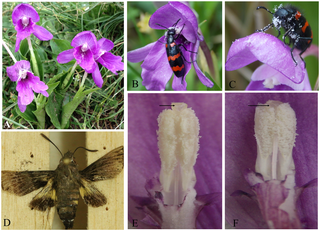Gingers (family Zingiberaceae) with about 1300 species in 52 genera are one of the earliest angiosperms that evolved in the Cretaceous with a broad tropical distribution. Most members of the family are pollinated by long distant foragers such as bees, birds and/or flies that mostly forage on the flowers to collect nectar Roscoea alpina is a true alpine species within the genus and is distributed between the elevations of 2130 m to 4270 m in the Himalayan regions.
Researchers from Xishuangbanna Tropical Botanical Garden (XTBG) investigated the pollination biology of R. alpina, to test for potential evidence supporting a pollination syndrome.
They recorded the floral biology and observed the floral visitors of R. alpina at three sites across central Nepal, for two consecutive years (2015–2016) from early to Mid-June. Their observations revealed that a beetle (Mylabris sp.) and a moth (Macroglossum nycteris) were the only observed floral visitors of R. alpina.
They focused on how pollination occurred in R. alpine and asked whether the observed visitors (beetle and/or moth) act as the effective pollinator of R. alpine. They then asked how the floral spectral signal of R. alpine fit with the currently known framework for beetle and moth vision.
They showed that, different to classic pollination syndromes, R. alpina employed dual pollination mechanisms to help maximize its reproductive success in a sub-alpine zone of unreliable pollinator service.
The results suggest that the evolution of autonomous selfing as a predominant mode of reproduction coupled with beetle pollination system in R. alpina provide reproductive assurance to this alpine ginger.
The involvement of a beetle (Mylabris sp.) as the only pollinator of R. alpina suggests that a novel type of plant-pollinator interaction may be present to what has previously been considered for beetle pollination, and indicates that beetles play an important role for improving the genetic diversity of R. alpina in the Nepalese Himalayas.
The study entitled “Ginger and the beetle: Evidence of primitive pollination system in a Himalayan endemic alpine ginger (Roscoea alpina, Zingiberaceae)” has been published in PLoS ONE.

Plant and pollinator. (Images by Babu Ram Paudel)

